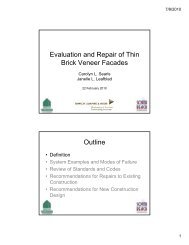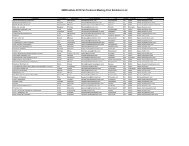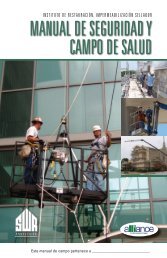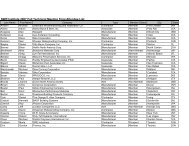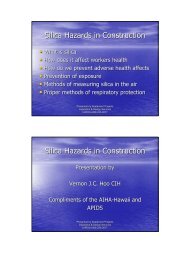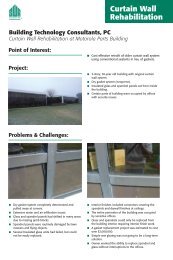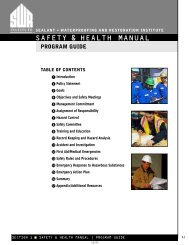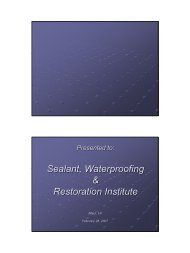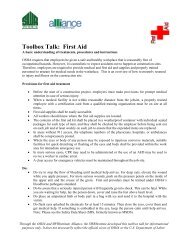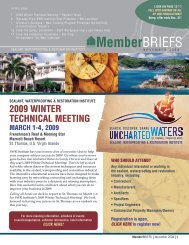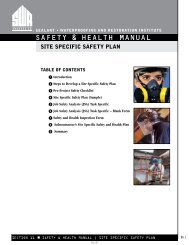CORROSION MITIGATION IN BALCONY REPAIRS What is ...
CORROSION MITIGATION IN BALCONY REPAIRS What is ...
CORROSION MITIGATION IN BALCONY REPAIRS What is ...
Create successful ePaper yourself
Turn your PDF publications into a flip-book with our unique Google optimized e-Paper software.
<strong>CORROSION</strong> <strong>MITIGATION</strong> <strong>IN</strong><br />
<strong>BALCONY</strong> <strong>REPAIRS</strong><br />
KATHER<strong>IN</strong>E A. KLOSOWSKI-BLATZ<br />
<strong>What</strong> <strong>is</strong> Corrosion?<br />
In steel reinforced concrete, corrosion <strong>is</strong> the deterioration of steel caused by a<br />
change in its concrete surroundings (environment).<br />
The “chemical change” can be brought on by many different factors:<br />
• CHLORIDES<br />
• CARBONATION<br />
• SULFATE ATTACK<br />
• DISSIMILAR METALS<br />
04.11.2004 2
CAST <strong>IN</strong> CHLORIDES<br />
CARBONATION<br />
WATER + CARBON DIOXIDE
DISSIMILAR METALS<br />
BASIC TERM<strong>IN</strong>OLGY<br />
• PASSIVAT<strong>IN</strong>G LAYER: Iron Oxide film on steel that naturally<br />
inhibits corrosion (mill scale).<br />
• Basically a thin layer of RUST that naturally protects the steel. It<br />
<strong>is</strong> stable so long as the concrete at the steel-concrete interface<br />
has an alkalinity of ph 10 or greater
WHY DO WE GET SPALL<strong>IN</strong>G?<br />
RUST EXPANDS TO 8 TIMES<br />
THE VOLUME OF STEEL<br />
LEAD<strong>IN</strong>G TO LOSS OF<br />
STRUCTURAL <strong>IN</strong>TEGRITY<br />
04.11.2004 7<br />
<strong>CORROSION</strong><br />
ALUM<strong>IN</strong>UM RAILS
BASIC TERM<strong>IN</strong>OLOGY<br />
• ANODE: Electrode at which net Oxidation Process occurs, th<strong>is</strong> <strong>is</strong><br />
where you see rust<br />
• CATHODE: Electrode at which a net Reduction Reaction occurs<br />
• ELECTROLYTE: Solution containing ions (Cl-, OH-) (CONCRETE)<br />
• RESISTIVITY – A measure of the ability of an electrolyte to res<strong>is</strong>t<br />
the flow of electric charge<br />
Patch Accelerated Corrosion<br />
“Incipient Anode”<br />
04.11.2004 10
BASIC TERM<strong>IN</strong>OLOGY<br />
RELATIVE HUMIDITY<br />
Corrosion Currents, uA<br />
600<br />
UNTREATED<br />
500<br />
400<br />
300<br />
200<br />
100<br />
0<br />
45 50 55 60 65 70 75 80 85 90 95 100 95 90 85 80 75<br />
Wetting Cycle<br />
% Relative Humidity<br />
Drying Cycle<br />
04.11.2004 11<br />
BASIC TERM<strong>IN</strong>OLOGY<br />
• DISSILIMAR METALS – two metal<br />
components in an electrolyte that<br />
could form an anode-cathode<br />
relationship when connected by a<br />
metallic path<br />
Gold<br />
316 SS<br />
Steel<br />
• ELECTROMOTIVE SERIES - l<strong>is</strong>t<br />
of metals whose order indicates<br />
the relative tendency to be<br />
oxidized, or to give up electrons<br />
Chromium<br />
Zinc<br />
Aluminum
<strong>CORROSION</strong>:<br />
<strong>What</strong> Do You Need?<br />
• Steel (Fe++)<br />
• Chlorides (Cl-)<br />
• Oxygen (O 2 )<br />
• Water (H 2 O)<br />
or another metal<br />
• OTHER Symbols to know<br />
• Electrons (e-) like a battery corrosion has an electrical current<br />
• Hydroxyl (OH-) basic / alkali available in concrete solution<br />
• Hydrogen (H+) acid – causes the pH to lower<br />
Electrochemical Corrosion Reactions<br />
•Fe ++ + 2Cl - FeCl 2<br />
•FeCl 2 + H 2 O + OH - Fe(OH) 2 + H + + 2Cl -<br />
•2Fe(OH) 2 + ½O 2<br />
-<br />
Fe 2 O 3 + 2H 2 O anode<br />
•½O 2 + H 2 O + 2e - 2 OH - cathode<br />
04.11.2004 14
<strong>CORROSION</strong> PROCESS<br />
l<br />
Corrosion <strong>is</strong> like a chain.<br />
The entire process can be<br />
interfered with if a link <strong>is</strong> broken.<br />
Initiator<br />
Water + Oxygen<br />
Concrete Reinforcing<br />
Fe +2<br />
+2<br />
A<br />
Passive layer<br />
no<br />
d<br />
e<br />
04.11.2004 15<br />
2 e -<br />
Cath<br />
ode<br />
2 OH OH<br />
<strong>CORROSION</strong> PREVENTION OPTIONS<br />
New Construction<br />
• COATED REBAR<br />
• NON-STEEL REBAR<br />
• ADMIXTURES<br />
• WATER REPELLENTS<br />
• DECK COAT<strong>IN</strong>GS / MEMBRANES<br />
04.11.2004 16
<strong>CORROSION</strong> CONTROL OPTIONS<br />
Restoration<br />
• REMOVAL OF CONTAM<strong>IN</strong>ATED CONCRETE<br />
• REBAR COAT<strong>IN</strong>GS<br />
• Epoxy<br />
• Cementicous<br />
• PATCH REPAIR MATERIAL WITH CI / W/O CI<br />
• FRP<br />
• GALVANIC PROTECTION<br />
• Zinc Rich Rebar Primers<br />
• Galvanic Anodes<br />
• ELECTROCHEMICAL OPTIONS<br />
• ICCP – Impressed Current Cathodic Protection<br />
• Chloride Extraction / Re-Alkalinization<br />
• ANTI-CARBONATION TREATMENTS<br />
• SURFACE APPLIED <strong>CORROSION</strong> <strong>IN</strong>HIBITORS<br />
REMOVE CONTAM<strong>IN</strong>ATED<br />
CONCRETE
REMOVAL OF CONTAM<strong>IN</strong>ATED<br />
CONCRETE<br />
REBAR COAT<strong>IN</strong>G AND BOND<strong>IN</strong>G AGENT
04.11.2004 21<br />
GALVANIC PROTECTION<br />
Zinc Rich Primers
GALVANIC PROTECTION<br />
Galvanic Anodes<br />
GALVANIC PROTECTION<br />
Anodes
PERIMETER <strong>REPAIRS</strong><br />
REPAIR MORTARS<br />
with or without C.I.
REPAIR MATERIALS<br />
• SCHOOLS OF THOUGHT<br />
1. Match the host concrete character<strong>is</strong>tics<br />
2. Polymer modified, high strength, high density mortars<br />
ELECTRICAL POTENTIAL<br />
DIFFERENTIAL<br />
04.11.2004 28
GALVANIC PROTECTION<br />
Anodes Need Conductive Environment<br />
Repair Mortar<br />
must have a<br />
res<strong>is</strong>tivity of less<br />
than<br />
15,000 Ohms-cm<br />
RAIL<strong>IN</strong>G GROUT POCKETS
Effectiveness of Various Protection<br />
Materials on Active Corrosion<br />
Urethane<br />
Membrane<br />
Silane/Acrylic<br />
Cementitious Coating<br />
Tested at 60%<br />
Relative Humidity<br />
Silane Sealer<br />
<strong>CORROSION</strong> <strong>IN</strong>HIBITOR<br />
Tested at 85%<br />
Relative Humidity<br />
0 20 40 60 80 100<br />
% Reduction in Corrosion<br />
Conventional protection methods may prevent corrosion,<br />
but they are not as effective on active corrosion<br />
04.11.2004 31<br />
Silanes:<br />
Made with Different Functionality<br />
(C 2<br />
H 5<br />
O) 3<br />
Si<br />
Alkyltrialkoxysilane<br />
Hydrophobic Effect<br />
H 2 N<br />
Si(OC 2 H 5 ) 3<br />
Aminoalkyltrialkoxysilane<br />
Corrosion inhibitor<br />
F C 3<br />
CF 2<br />
CF2<br />
CF 2<br />
CF2<br />
CF 2<br />
CH2<br />
CH 2<br />
Si(OC2 H 5 ) 3<br />
FluoroAlkyltrialkoxysilane<br />
R f<br />
Anti-Graffiti, Easy to Clean<br />
R f<br />
O<br />
Si<br />
O<br />
X<br />
H<br />
O<br />
O<br />
Si<br />
Si<br />
O<br />
O<br />
Si<br />
O<br />
O<br />
Si<br />
Si<br />
O<br />
Silane Molecule<br />
Substrate e.g. Concrete<br />
04.11.2004 32
Corrosion Inhibitors<br />
• Inorganic Inhibitors<br />
• Organic Inhibitors<br />
• Cathodic<br />
• Anodic<br />
• Mixed<br />
Corrosion inhibitors are used to prevent or delay corrosion<br />
of metals exposed to corrosive environments.<br />
Cathodic inhibitors decrease cathodic corrosion reaction.<br />
Anodic inhibitors decrease anodic corrosion reaction.<br />
Mixed inhibitors decrease cathodic and anodic corrosion reaction.<br />
04.11.2004 33<br />
Corrosion Continuing<br />
04.11.2004 34
<strong>CORROSION</strong> <strong>IN</strong>HIBITOR<br />
Properties of an Effective<br />
Corrosion Inhibitor<br />
• Works on both chloride and carbonation induced corrosion – in concrete.<br />
• Effective in high humidity environments<br />
• Must change electrical properties of steel/concrete<br />
• Long service life<br />
• Effective on concrete with micro-cracks<br />
• Proven Laboratory and Field Results<br />
04.11.2004 36
SURFACE APPLIED <strong>CORROSION</strong> <strong>IN</strong>HIBITOR<br />
Ex<strong>is</strong>ting Corrosion in Concrete<br />
600<br />
500<br />
Current, µA<br />
400<br />
300<br />
200<br />
100<br />
Untreated<br />
<strong>CORROSION</strong><br />
<strong>IN</strong>HIBITOR<br />
0<br />
0 1 5 10 15 20 25 30 35 40 45 48<br />
Weeks of Salt Water Exposure<br />
Corrosion on Cracked Specimens<br />
Corrosion on Cracked Specimens for Different Systems Using FHWA-<br />
RD-98-153 Protocol<br />
• Black Bars -- 4053 mV<br />
• Epoxy, 0.5% damage -- 971 mV<br />
• Epoxy, 0.004% damage -- 325 mV<br />
• Copper-clad -- 111 mV<br />
• 316 SS -- 5 mV<br />
• SURFACE APPLIED <strong>CORROSION</strong> <strong>IN</strong>HIBITOR -- 58 mV
FIELD PERFORMANCE<br />
TEST IT!!!<br />
39<br />
Performance of<br />
Corrosion Inhibitor<br />
Corrosion Rate Before C.I. CP<br />
Corrosion Rate After CP C.I.<br />
04.11.2004 40
BUT WAIT…..<br />
• WHAT ABOUT CRACKS???<br />
• ONCE <strong>CORROSION</strong> IS MITIGATED…..then you MAY be able to<br />
install a coating or crack sealer.<br />
DECK COAT<strong>IN</strong>GS<br />
• Improve appearances of patchy surfaces<br />
• Provide water-proofing<br />
• Prevent new chlorides<br />
• EXCELLENT <strong>IN</strong> “LOW COVER” Problem areas
DECK COAT<strong>IN</strong>GS<br />
• WATCH OUT FOR<br />
• Breathability<br />
• Durability<br />
• SURFACE PREP REQUIREMENTS<br />
REVIEW<br />
• LOTS OF OPTIONS!<br />
• Know the root cause of your corrosion<br />
• STOP IT FIRST!<br />
• Match the repair solution to the problem<br />
• Don’t assume …..check compatibilities<br />
• Remember to use galvanic anodes repair material must have a<br />
res<strong>is</strong>tivity of less than 15,000 ohms-cm<br />
• Isolate d<strong>is</strong>similar metals so electrical potential differentials<br />
cannot be establ<strong>is</strong>hed
THANK YOU!<br />
THANK YOU.<br />
BASF Construction Chemicals, LLC –<br />
Building Systems<br />
889 Valley Park Drive<br />
Shakopee, MN 55379<br />
952-496-6000 Phone



